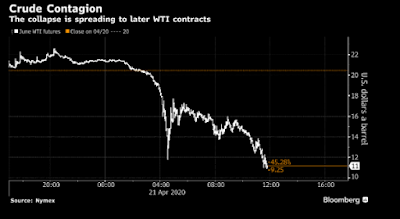Another reminder of what happens when imbalances in the physical/financial markets compound in a vicious manner:
The June oil contract has halved in price so far today. Expect the oil ETF fund to lose a lot of the flows it gained in recent weeks.

The price of a WTI barrel of oil rebounded on Tuesday and is now back in the black, mimicking the June futures contract—rather than May’s future contract that is set to expire Tuesday afternoon. But the volatility is not yet behind us. The June contract for West Texas Intermediate (WTI) was trading down more than 65% on the day at $6.5 per barrel at 13:45pm EST. The spot prices yesterday were closely linked to the May futures contract, which were also in the red on Monday. Today, however, on the day that this CLK20 futures contract is set to expire, WTI prices are tracking the June futures instead. The May futures contract, or CLK20, rose $41.88 on Tuesday, reaching $4.25.
The extreme volatility in the oil markets this week is largely the result of the timing for the May 2020 futures contract which expires this afternoon, helped along by limited storage and severe demand destruction. US President Donald Trump added to the volatility today, asking the Energy and Treasury Secretaries to come up with a plan to aid US oil and gas companies by making funds available.
The US President also said he would “take a look” at the suggestion that the United States should block Saudi oil from coming into the U.S. to help alleviate the domestic glut. As we move onto the June futures contract, more volatility is in store, as the fast-paced developments in the U.S. industry prompted by a desperate attempt to keep the industry’s head above water will continue to wildly swing prices up and down for the foreseeable future, until the pandemic is behind us, when demand is expected to be somewhat restored.

The price of a WTI barrel of oil rebounded on Tuesday and is now back in the black, mimicking the June futures contract—rather than May’s future contract that is set to expire Tuesday afternoon. But the volatility is not yet behind us. The June contract for West Texas Intermediate (WTI) was trading down more than 65% on the day at $6.5 per barrel at 13:45pm EST. The spot prices yesterday were closely linked to the May futures contract, which were also in the red on Monday. Today, however, on the day that this CLK20 futures contract is set to expire, WTI prices are tracking the June futures instead. The May futures contract, or CLK20, rose $41.88 on Tuesday, reaching $4.25.
The extreme volatility in the oil markets this week is largely the result of the timing for the May 2020 futures contract which expires this afternoon, helped along by limited storage and severe demand destruction. US President Donald Trump added to the volatility today, asking the Energy and Treasury Secretaries to come up with a plan to aid US oil and gas companies by making funds available.
The US President also said he would “take a look” at the suggestion that the United States should block Saudi oil from coming into the U.S. to help alleviate the domestic glut. As we move onto the June futures contract, more volatility is in store, as the fast-paced developments in the U.S. industry prompted by a desperate attempt to keep the industry’s head above water will continue to wildly swing prices up and down for the foreseeable future, until the pandemic is behind us, when demand is expected to be somewhat restored.
As an Amazon Associate I earn from qualifying purchases.
Comments
Post a Comment